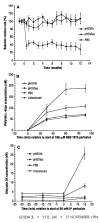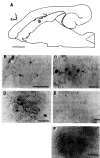Long-term behavioral recovery in parkinsonian rats by an HSV vector expressing tyrosine hydroxylase
- PMID: 7669103
- PMCID: PMC2638002
- DOI: 10.1126/science.266.5189.1399
Long-term behavioral recovery in parkinsonian rats by an HSV vector expressing tyrosine hydroxylase
Abstract
One therapeutic approach to treating Parkinson's disease is to convert endogenous striatal cells into levo-3,4-dihydroxyphenylalanine (L-dopa)-producing cells. A defective herpes simplex virus type 1 vector expressing human tyrosine hydroxylase was delivered into the partially denervated striatum of 6-hydroxydopamine-lesioned rats, used as a model of Parkinson's disease. Efficient behavioral and biochemical recovery was maintained for 1 year after gene transfer. Biochemical recovery included increases in both striatal tyrosine hydroxylase enzyme activity and in extracellular dopamine concentrations. Persistence of human tyrosine hydroxylase was revealed by expression of RNA and immunoreactivity.
Figures



Comment in
-
Behavioral effects and gene delivery in a rat model of Parkinson's disease.Science. 1995 Aug 11;269(5225):856-7. doi: 10.1126/science.7638605. Science. 1995. PMID: 7638605 No abstract available.
References
-
- M. D. Yahr and K. J. Bergmann, Eds., Parkinson’s Disease (Raven, New York, 1987).
-
- Yahr MD, Duvoisin RC, Schear MJ, Barrett RE, Hoehn MM. Arch Neurol. 1969;21:343. - PubMed
Publication types
MeSH terms
Substances
Grants and funding
LinkOut - more resources
Full Text Sources
Other Literature Sources
Medical

